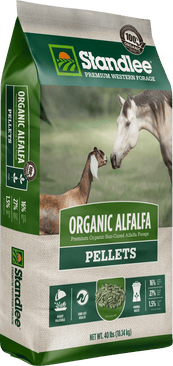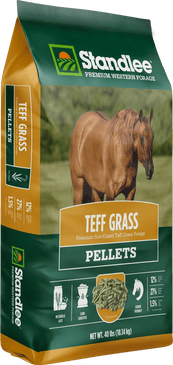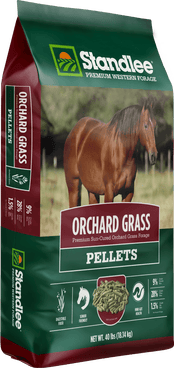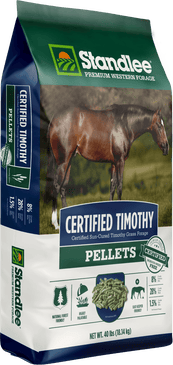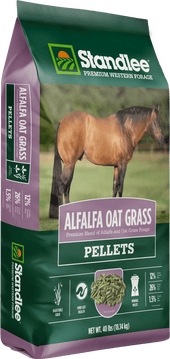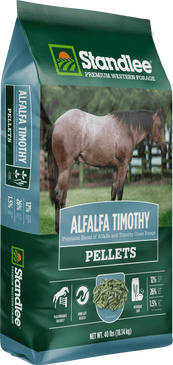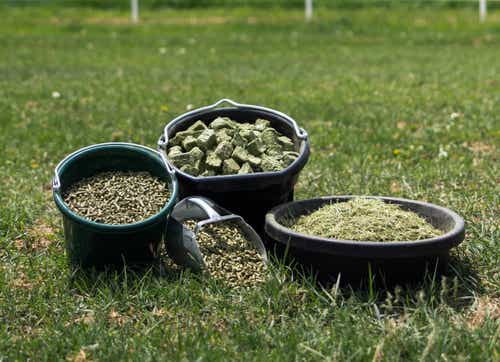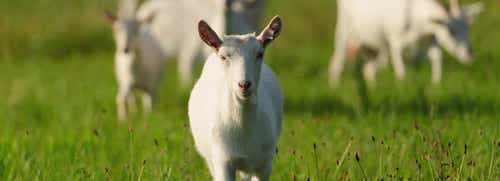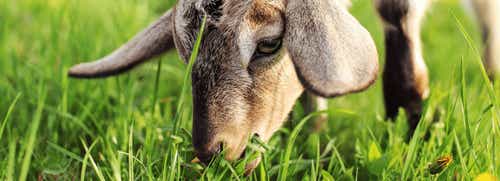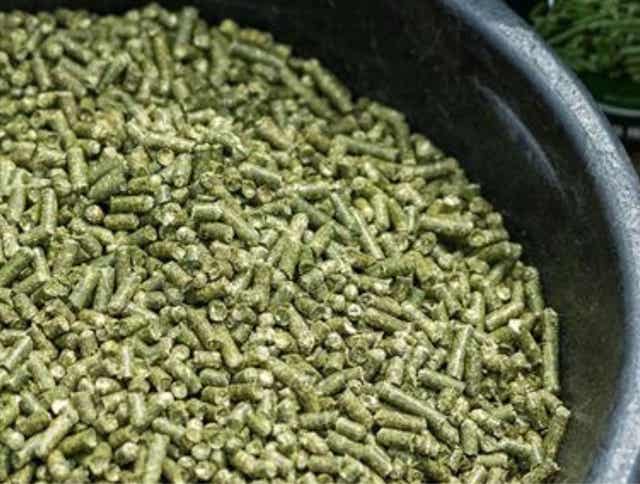
The Scoop on Forage Pellets for Horses
Are you curious about hay pellets? What are they, how are they made, how do you feed them, and which horses will benefit from consuming forage pellets?
How Standlee Makes Pellets
Hay pellets consist of dried forage, such as alfalfa and grasses, that are formed into 0.25" wide x 0.75 – 1.25" long pieces. To make a hay pellet, Standlee Forage first grows the plants to the proper maturity stage, then cuts, dries, and bales the forage into conventional bales for storage. The hay is stored to prevent any damage or bleaching associated with exposure of the forge to sun or inclement weather.
Throughout the year, this baled hay is chopped and mixed with steam, and pushed through a dye with pressure to form the pellet. Once made, hay pellets are dried to a moisture level that allows proper storage. Standlee currently manufactures Alfalfa Pellets, Organic Alfalfa Pellets, Alfalfa Oat Pellets, Alfalfa Timothy Pellets, Orchard Grass Pellets, Certified Timothy Grass Pellets, and Teff Grass Pellets.
Benefits of Feeding Pellets
Crafted from the finest hay, our hay pellets ensure your horses receive a balanced and high-quality diet. Our state-of-the-art manufacturing process preserves the natural goodness of the hay, making it a healthy and palatable option for your horses.
High-quality forage for your horses all year long
Hay quality and quantity begins to decrease as the winter approaches. Stocking up on high-quality Standlee hay pellets is a great way to ensure you have enough feed, provide high-quality nutrients for your horses through the cold weather, and provides less stress for hay storage as the conditions get wet.
Prevent seasonal colic and health risks with hay pellets
Adding Standlee’s premium hay pellets into your horse’s diet will not only optimize the nutrition they receive. Soaked hay pellets are a great way to increase your horse’s water intake as their desire to drink water starts to decrease. It also provides an opportunity to add in additional minerals, vitamins, and supplements into their feed as it is easily mixed in to the soaked forage.
Hay pellets improve digestion in horses as they are made from high-quality hay that’s chopped and compressed. The pellets break down hay fibers, making them easier to digest. Feeding your horses hay pellets can help prevent digestive issues like colic and ulcers, promoting a healthy digestive system.
Support your horse’s health with hay pellets
As horses get older their ability to chew hay can become a challenge as their teeth wear down. Providing soaked pellets ensures that your horse is getting enough forage in their diet to maintain their overall health and well-being. Measuring out your hay pellets by weight also helps you track how much your horse is eating, and prevents food waste.
Hay pellets make feeding a breeze
One of the significant advantages of hay pellets is the convenience they offer. Unlike traditional hay bales, hay pellets are compact and easy to handle, taking up less storage space and creating less mess. They also have a longer shelf life, ensuring a fresh and reliable food source for your horses at all times.
In summary, hay pellets for horses are a practical and beneficial choice for feeding your horses. They provide essential nutrients, improve digestion, and offer convenience for horse owners. Consider incorporating hay pellets into your horse’s diet to ensure their optimal health and happiness.
Frequently Asked Questions About Forage Pellets
Are hay pellets good for horses?
When compared to long-stem forage and even hay cubes, hay pellets are less dusty, which can reduce the risk of respiratory irritation, thus promoting respiratory health. Senior horses that have more complicated dental problems or greatly reduced chewing ability may benefit from the feeding of hay pellets.
Are hay pellets better than hay for horses?
A 1991 study compared horses that were fed long-stem alfalfa hay vs alfalfa pellets. The study showed there was no differences in digestibility for energy, protein, fiber, calcium, phosphorus, magnesium, potassium and the trace minerals copper, zinc and manganese.
It is important to mention that long-stem forage is beneficial for your horse’s health. If your horse has the ability to chew hay, it is recommended that you balance your horse’s diet with long-stem forage hay in addition to high-quality forage such as hay pellets.
How to feed hay pellets
The mechanical process of making a forage pellet does not change the digestibility of the forage. Therefore, the digestibility of a bale of high-quality alfalfa is the same as a pellet made with the same high-quality alfalfa. When replacing long-stem baled hay with forage pellets, you would replace one pound of hay with one pound of forage pellets. A common occurrence reported by horse owners is less waste associated with feeding pellets than feeding long-stem baled forage.
To swallow and digest a forage pellet, the horse must properly chew the pellet. If the pellet is not properly chewed, the horse can potentially choke. We recommended to soak the pellets in water prior to feeding them. To properly soak forage pellets, the pellets should be submerged in water for 30-60 minutes prior to feeding. This will soften the pellets until they dissolve into an easy-to-swallow forage slurry.
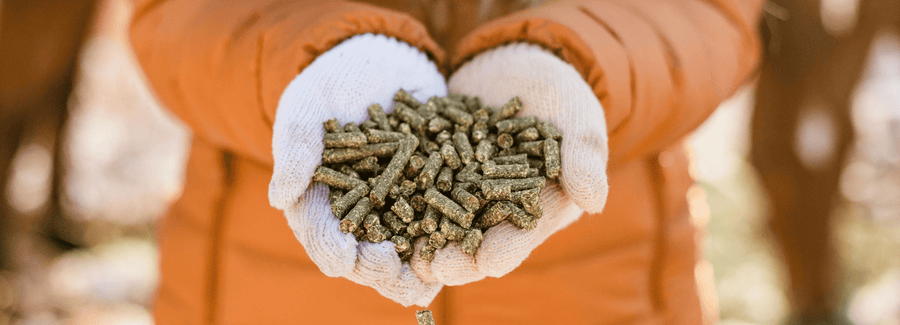
Types of Horses that Benefit from Forage Pellets
High-quality hay pellets can benefit many types of horses.
Poor Dentition
First, any horse that is having difficulty chewing due to poor or missing teeth can benefit from soaked forage pellets. The soaked forage pellet provides fiber that is shorter in length and easy to swallow for horses with dental issues.
Underweight Horses
Horses that are underweight are also good candidates for forage pellets. The high-quality forage utilized to make Standlee Premium Western Forage pellets will provide an elevated calorie intake compared to most local hay sources.
Performance Horses
For horses with a higher activity level, alfalfa pellets are a good choice since they provide the protein needed for muscle and bone development and repair.
Horses with Gastric Ulcers
The calcium in alfalfa pellets buffers stomach acid, potentially reducing the occurrence of gastric ulcers in performance horses.
Hay Pellets For Certified Noxious Weed Free Needs
Federal and State authorities require certified noxious weed free forage to be fed in protected national lands. Certified Standlee products are ideal for horses used for trail riding or guided pack trips.
Finally, forage pellets can be fed to all types of horses when baled hay is in short supply or when the quality of local hay is marginal. Replacing all or part of baled hay with forage pellets will provide high-quality nutrient-rich forage for you horses. If you have questions, please contact the nutritionists at Standlee Premium Western Forage, or consult with your veterinarian.
Reviewed and approved by a Standlee nutritional expert.
References:
Department of Animal and Food Sciences


